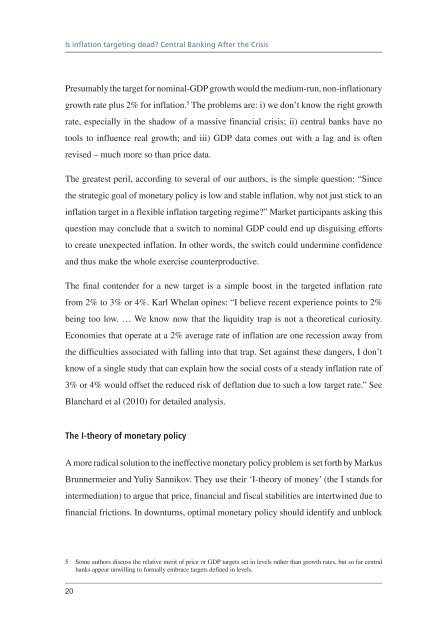You also want an ePaper? Increase the reach of your titles
YUMPU automatically turns print PDFs into web optimized ePapers that Google loves.
Is <strong>inflation</strong> <strong>targeting</strong> dead? Central Banking After the CrisisPresumably the target for nominal-GDP growth would the medium-run, non-<strong>inflation</strong>arygrowth rate plus 2% for <strong>inflation</strong>. 5 The problems are: i) we don’t know the right growthrate, especially in the shadow of a massive financial crisis; ii) central banks have notools to influence real growth; and iii) GDP data comes out with a lag and is oftenrevised – much more so than price data.The greatest peril, according to several of our authors, is the simple question: “Sincethe strategic goal of monetary policy is low and stable <strong>inflation</strong>, why not just stick to an<strong>inflation</strong> target in a flexible <strong>inflation</strong> <strong>targeting</strong> regime?” Market participants asking thisquestion may conclude that a switch to nominal GDP could end up disguising effortsto create unexpected <strong>inflation</strong>. In other words, the switch could undermine confidenceand thus make the whole exercise counterproductive.The final contender for a new target is a simple boost in the targeted <strong>inflation</strong> ratefrom 2% to 3% or 4%. Karl Whelan opines: “I believe recent experience points to 2%being too low. … We know now that the liquidity trap is not a theoretical curiosity.Economies that operate at a 2% average rate of <strong>inflation</strong> are one recession away fromthe difficulties associated with falling into that trap. Set against these dangers, I don’tknow of a single study that can explain how the social costs of a steady <strong>inflation</strong> rate of3% or 4% would offset the reduced risk of deflation due to such a low target rate.” SeeBlanchard et al (2010) for detailed analysis.The I-theory of monetary policyA more radical solution to the ineffective monetary policy problem is set forth by MarkusBrunnermeier and Yuliy Sannikov. They use their ‘I-theory of money’ (the I stands forintermediation) to argue that price, financial and fiscal stabilities are intertwined due tofinancial frictions. In downturns, optimal monetary policy should identify and unblock5 Some authors discuss the relative merit of price or GDP targets set in levels rather than growth rates, but so far centralbanks appear unwilling to formally embrace targets defined in levels.20



